Translation of Trademark 商标词的翻译
[英语作文]论商标出口商品名称的翻译
![[英语作文]论商标出口商品名称的翻译](https://img.taocdn.com/s3/m/0e87752100f69e3143323968011ca300a6c3f680.png)
[英语作文]On Translation of Trade Names and Names of Export Commodities 论商标出口商品名称的翻译英文回答:Title: On Translation of Trade Names and Names of Export CommoditiesThe translation of trade names and names of export commodities is a crucial aspect of international business communication. It not only facilitates cross-border marketing but also plays a significant role in shaping the global image of a brand. Effective translation can enhance marketability, while poor translation can lead to confusion or even damage to the brand's reputation. This essay will discuss the strategies and considerations involved in translating these commercial terms.Firstly, it is essential for the translator to maintain the brand's identity and distinctiveness when rendering its name into another language. A direct translation may not always convey the intended brand message or reflect its cultural nuances. For example, the Chinese smartphone brand "小米" is known in English as "Xiaomi," rather than a literal translation, preserving its unique identity and pronunciation. Translators should strive for a balance between local relevancy and global consistency.Secondly, cultural sensitivity is paramount in the translation process. The connotations and associations that a name carries in one culture may differ significantly from those in another. For instance, the color red is associated with luck and prosperity in China, which is why many Chinese brands use it extensively. However, in Western cultures, red can sometimes be seen as aggressive or dangerous. Therefore, the translator must adapt the name to ensure it resonates positively with the target audience.Thirdly, simplicity and memorability are key factors in effective trade name translation. A name that is too complex or difficult to pronounce may hinder recognition and recall. For example, the Japanese car brand "Toyota" has a simple and easily recognizable name, contributing to its widespread success. Translators should aim for clarity and ease of use when creating translated names.Fourthly, legal considerations cannot be overlooked. Trade names need to be checked against existing trademarks to avoid infringement, which could result in legal action. Translated names must also comply with the trademark laws of the countries where the goods will be sold. This requires thorough research and often consultation with legal professionals.Fifthly, the translator should consider the product's characteristics and the market it is targeting. A name that works well for luxury goods may not besuitable for mass-market items. Similarly, a name aimed at a youthful demographic might differ from one targeting an older population. The translator must understand the product's positioning and tailor the translation accordingly.Lastly, the issue of homophony and heteronymy should be addressed. Words that sound alike but have different meanings can create confusion or misinterpretation. For example, the Spanish word "pija" means "old woman," whereas the similar-sounding "pita" refers to bread. Mistakes like these can lead to embarrassment or misbranding.In conclusion, the translation of trade names and names of export commodities is a multifaceted task that requires careful attention to detail, cultural awareness, an understanding of the brand's essence, legal knowledge, and marketing savvy. The translator must walk a fine line between fidelity to the original and adaptation to new cultural contexts. Successful translation in this realm ensures that brands maintain their integrity while connecting with diverse audiences across linguistic and cultural boundaries.中文回答:题目:商号与出口商品名称的翻译问题商号和出口商品名称的翻译是国际商务交流的一个重要方面。
从跨文化交际角度分析商标名称的翻译

校园英语 / 翻译探究解,因此译文通过释义法直接口译出原文的实际意义,更好地传递了源语的文化信息。
译员在现场处理文化信息时,应该注意:在准确传递文化信息的同时,尽可能保留源语文化信息的表达方式;在目的语的听众明显不能接受的情况下,大胆采取变通的表达方式。
三、结语除了上述几种现场及时进行文化信息的补偿方法,口译员不但要具备扎实的双语语言能力,而且还要有双文化乃至多元文化的知识。
文化差异对译员造成的严重问题,比语言结构造成的要多得多。
因此,培养跨文化交际意识,以克服口译过程中文化信息走失是非常有必要的。
跨文化意识有助于译员在即席的口译中辨别出哪些内容是目标语听众不能理解的,进而对该内容进行有效、及时、准确的处理。
译者不仅要深入了解自己民族的文化,还要深入了解外国文化。
要掌握源语言和目的语的语言系统,要努力了解双方民族的文化、历史、宗教、民俗等的渊源与发展,最大程度地去了解两种文化差异。
不仅如此,还要不断地把两种文化加以比较,以尽可能完整、准确地传达源语特有的文化意象,以避免信息走失。
参考文献:[1]周跃新,汤仁云.试论翻译中文化信息的走失与补偿[J].吉林省教育学院学报,2008(8):95-97.[2]刘静溪.口译中文化信息缺失及应对策略探究[J].兰州教育学院学报,2015(6):150-151.[3]李明.英汉互动翻译教程[M].武汉大学出版社,2006:79.[4]尹富林,阮玉慧.英汉互译——理论与实践[M].北京:中国科学技术大学出版社,2007:273.[5]Nida,E.A.Towards A Science of Translating:With Special Reference to Principles and Procedures involved in Bible Translating[M].Leiden:E.J.Brill,1964.[6]刘宓庆.口笔译理论研究[M].北京:中国对外翻译出版公司,2004.从跨文化交际角度分析商标名称的翻译重庆广播电视大学/郑筱【摘要】任何商标词都具有自身的文化内涵。
谈商务英语的语言特点及翻译

收稿日期:2005-03-16作者简介:李玉香(1967-),女,山东临清人,同济大学外国语学院英语系讲师,英语语言学硕士,研究方向为语言、文化与翻译。
谈商务英语的语言特点及翻译李玉香(同济大学外国语学院,上海 200092)摘要:商务英语传达商务理论和实务等信息,其词汇专业性极强,语体规范正式,语句简洁明快,多社交性套语,也不乏比喻、夸张、对比等修辞手段。
商务活动参与者应具备较强跨文化意识,商务英语翻译应遵守“忠实、准确、统一”三原则,但商标翻译不应一味强调“忠实”,而应力求实现“交际功能”对等,达到商品宣传目的。
关键词:商务英语;专业知识;跨文化意识;翻译中图分类号:H059 文献标识码:A 文章编号:10002579(2005)0320121204Linguistic Features of Business E nglish and TranslationLI Y u 2xiang(English Department ,T ongji University ,Shanghai 200092,China )Abstract :Business English is full of specific business terms ,featuring formal —consultative style ,logic and concise sentences ,polite formulae as well as rhetoric strategies like metaphor ,hyperbole and contrast etc.Business English translators should have strong cross -cultural awareness ,following the three principles of“faith fulness ”“exactness ”and “consistence ”.H owever ,the translation of trademark w ords should focus on e 2quivalence of communicative function rather than on superficial faith fulness to the original linguistic form.K ey w ords :Business English ;professional knowledge ;cross -cultural awareness ;translation 商务英语属于专门用途英语的一个分支,一种变体。
pp11.of E-C专有名词 (商标)
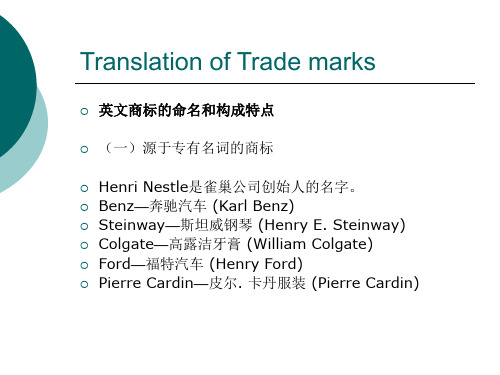
英文商标汉译的三个标准: “意美、音美、形美”的统一
(一)、意美 美国老牌指甲油Cutex “蔻丹” 内衣品牌Maidenform “媚登峰” Mild Seven“万事发”
(二)音美 雷达公司(Raid)生产的杀蟑气雾剂的商 标为pif-paf (“必扑”)
(三)形美 Flora “芙露”(化妆品)、 Camay“佳美”(香皂) Polaroid 照相机“拍立得”,眼镜“宝丽 来” Dove 护肤用品“多芬”;巧克力 “德芙”
2. 音译 Dunhill —— 登喜路(香烟) Band-Aid —— 邦迪(创可贴) Sony —— 索尼(随身听) L’oreal —— 欧莱雅(化妆品) Colgate —— 高露洁(牙膏) Pantene ——潘婷 (洗发水) Revlon —— 露华浓(化妆品)
• 1.Big Banana(一种黄颜色、笔杆粗 大的圆珠笔)香蕉笔 2.Blue Ribbon(啤酒品牌)蓝带 • 3.Camel(香烟)骆驼 • 4.Tylenol(药品) 泰诺 • 5.Kiss Me(唇膏)奇士美 6.Dakmane(安眠药)带尔眠 7.Lacovo(饮料)乐口福 8.Sure(除体臭喷雾剂,deodorant) 舒尔
Note:cultural difference
Poison “百爱神”
商标翻译参见潘红 主编 《商务英语英 汉翻译教程》P155-173
11
Ex. Translate the following trademark into Chinese:
• • • • • • • • 1.Big Banana(一种黄颜色、笔杆粗大的圆珠笔) 2.Blue Ribbon(啤酒品牌) 3.Camel(香烟) 4.Tylenol(药品) 5.Kiss Me(唇膏) 6.Dakmane(安眠药) 7.Lacovo(饮料) 8.Sure(除体臭喷雾剂,deodorant)
从接受美学看英文商标的汉译 任务下达书
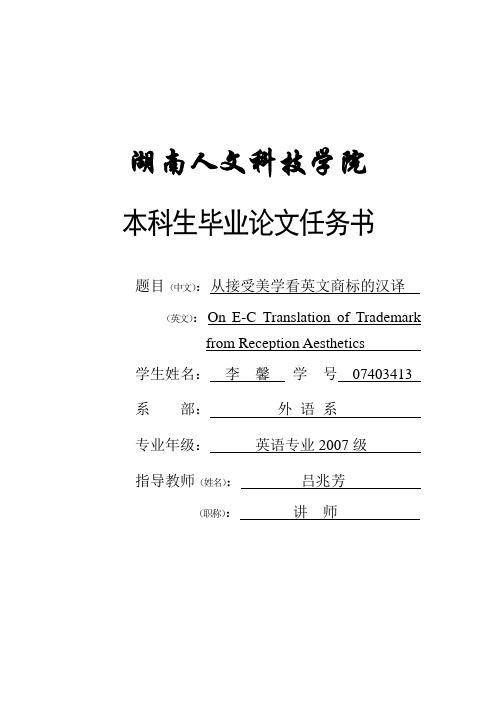
[4]王少娣.品牌名称翻译探讨队.外语与文化研究(第二辑)[M].上海:上海外语教育出版社,2002.
[5]许渊冲.译学要敢为天下先[J].中国翻译,1999(6).
[6]杨全红.英汉商业名称翻译原则初探[J].上海科技翻译,1995(12).
湖南人文科技学院
本科生毕业论文任务书
题目(中文):从接受美学看英文商标的汉译
(英文):On E-C Translation of Trademark from Reception Aesthetics
学生姓名:李馨学号********
系部:外语系
专业年级:英语专业2007级
指导教师(姓名):吕兆芳
(职称):讲师
国内外的译者,从不同的角度对英文商标的汉译做了大量的研究,可谓是见仁见智。但在一定程度上还是存在着不足与缺陷。例如,商标翻译过程中忽视了消费者的接受能力。研究如何从接受美学的角度把英文商标翻译好,如何使之适应消费者和文化发展的需求,如何采用更好的翻译方法让产品深入人心,为企业带来更大的经济效益已经引起了译者的广泛兴趣,此选题的目的和意义也在于此。
湖南人文科技学院教务处
毕业论文题目
从接受美学看英文商标的汉译
On E-C Translation of Trademark fromReception Aesthetics
论文题目类型
理论研究
题目来源
社会现实题
毕业论文时间
2010年12月-2011年5月
一、选题的目的及意义
现代商标作为使商品推向市场并占领市场的重要工具,其作用和意义不言而喻。商标作为商品的象征,是产品在广告宣传中的重要组成部分。从某种程度上来说,商标的好坏直接影响消费者对该产品的购买欲,当今社会中不难发现许多消费者拒接购买某种产品,仅仅是因为消费者不喜欢该商标。成功的商标在促进产品的销售方面发挥着极其重要的作用。随着市场经济推行的不断深入和经济全球化发展趋势的日益加深,大量的外国产品源源不断的涌入中国市场,各种产品在市场上的竞争也越来越大。那么,商标翻译的好坏直接影响了商品的竞争力。由此可见,英文商标的汉译更不容小觑。
A Touch On The Translation Of Trademark 商标翻译技巧
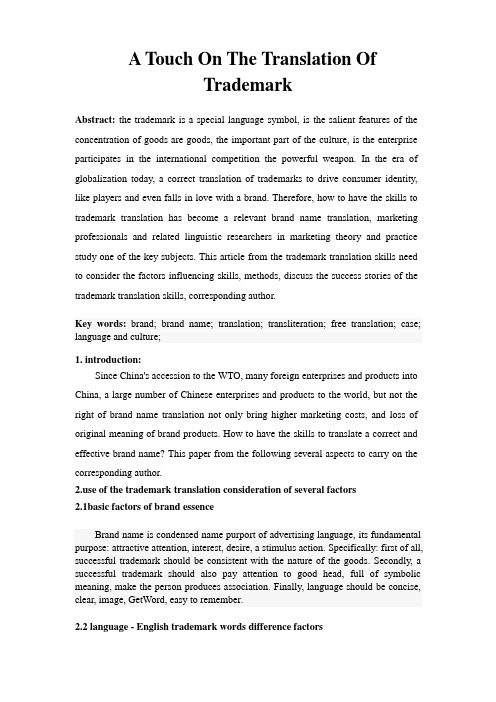
A Touch On The Translation OfTrademarkAbstract: the trademark is a special language symbol, is the salient features of the concentration of goods are goods, the important part of the culture, is the enterprise participates in the international competition the powerful weapon. In the era of globalization today, a correct translation of trademarks to drive consumer identity, like players and even falls in love with a brand. Therefore, how to have the skills to trademark translation has become a relevant brand name translation, marketing professionals and related linguistic researchers in marketing theory and practice study one of the key subjects. This article from the trademark translation skills need to consider the factors influencing skills, methods, discuss the success stories of the trademark translation skills, corresponding author.Key words: brand; brand name; translation; transliteration; free translation; case; language and culture;1. introduction:Since China's accession to the WTO, many foreign enterprises and products into China, a large number of Chinese enterprises and products to the world, but not the right of brand name translation not only bring higher marketing costs, and loss of original meaning of brand products. How to have the skills to translate a correct and effective brand name? This paper from the following several aspects to carry on the corresponding author.e of the trademark translation consideration of several factors2.1basic factors of brand essenceBrand name is condensed name purport of advertising language, its fundamental purpose: attractive attention, interest, desire, a stimulus action. Specifically: first of all, successful trademark should be consistent with the nature of the goods. Secondly, a successful trademark should also pay attention to good head, full of symbolic meaning, make the person produces association. Finally, language should be concise, clear, image, GetWord, easy to remember.2.2 language - English trademark words difference factorsEnglish and Chinese trademark word is brief, readable, easy to remember, and consumer interest in and appreciation of the character. However, due to the two languages of English and Chinese and the cultural differences between English and Chinese trademark words, also show a lot of differences, only when the translator is realized between the language and cultural differences, flexible, can make the trademark and trademark words play an equal effectiveness.2.3- English and Chinese cultural differences and cultural factors.Sociologist thinks, trademark is an expression of culture and communication tools, the translation of trademarks is the original language ( Source Language ) trademark translation into the target language ( Target Language ) trademark. In the English translation of trademarks, should fully realize and understand Chinese and English, each country consumer digital, animal, flower color, pattern, preferences and taboo. The trademark translation and target language country customs and culture to adapt. Only in this way can the trademark translation will be the target language country welcome.2.4 English and Chinese aesthetic factors of aesthetic differenceIn the oriental culture philosophy, art and literary language is to pay attention to the psychological time and space, especially emphasis on logic logic. Therefore, China's trademark tradition is the attention to psychological pleasure and aesthetic appreciation, pay attention to ethical education and emotional expression, pay attention to interest high, deep meaning, the pursuit of beautiful words, elegant taste, Shuxiang overflowing, good luck and happiness to you. But in the western culture philosophy, art and literary language of pay attention to is the natural space, especially emphasis space, substance, fact of nature authenticity, this leads to the Western brand culture attaches importance to the true nature and sensual pleasure, emphasizes the function and practical value.3 .methods of trademark translation skills3.1transliterationTransliteration is in does not violate the language specification and does not cause error association under the premise, according to its pronunciation, the use of a trademark and voice to word translation method.3.2literal translationLiteral translation is in the process of translation, the word as the basic unit of translation, taking into account contextual constraints, to retain the original trademark meaning and structure, reproduction in the form of content and style, to maximizeboth obtained with the original trademark equal advertising effectiveness, and maintain the original trademark sense of beauty.3.3combined translation transliterationThis method of translation is usually part of a trademark use transliteration according to pronunciation translated, and the other part is added with a special meaning of the corresponding Chinese characters, which makes the whole translation vivid and more in line with local cultural characteristics.3.4other special translation methodPhoto Gallery: not all the English trademark can through transliteration and translation are the perfect Chinese trademark name, so the Business Companies will be based on their own product characteristics and function to create a new brand.Direct: the so-called direct use, is completely preserved English trademarks, does not add or change for chinese. Such as "IBM" for" International Business Machines" is ( International Busine Machines Corp ), but in China, people are usually called" IBM", and do not address its full name in chinese.4. (Result) discuss some successful cases of trademark translationThe translation of trade mark requirement is very high, it requires the translator fully grasp the product nature at the same time, need to write in ornate style, concise language, connotation is rich, Lenovo better. Can say, excellent translation of trademarks can be a single word of gold., a be overwhelmed with admiration for effect. The following translation of a trademark case I think is very successful, now this translation skills are discussed and summarized:4.1 Benz ( Mercedes) and BMW ( BMW ): both are world famous automobile brand, although they themselves are meaningless, but its translation " Benz" but rich in meaning, both expressive and reflects the property of commodity. " Benz" and" Benz" in the voice of two is a homonym, so easy to link them together; semantically, also felt the car like a horse, horse galloping is inevitable. And" BMW" the Chinese translation for" BMW", showing the brand automobile distinguished and fun to drive. Visible, the two in China was very respected car brand translation reflects translators have great originality, become the trademark translation free translation legend.4.2 Coca-Cola ( Coca Cola ):" Cocacola, translated as" Coca Cola" combination". This is not only the continuation of the" Cocacola " English pronunciation, but also add the Chinese" delicious" and" happy" meaning, rhythm, musical, it will also have a taste of the beverage happy feeling, through the translation of the two different kinds of culture together. In addition, Coca Cola in the sound, meaning two respects to a proper extent reflects the beverage attributes, it gives people the message that:" thirst refreshing, an endless enjoyment". Although" Coca Cola" relative to the" Cocacola"and no special significance, but Chinese is sublimation of English, become a trademark in the English-Chinese translation of classic.4.3 Revlon ( Revlon ): the United States makeup brand" Revlon" is transliterated into" Revlon", this word is taken from the Chinese Ancient Poetry:" cloud would like to dress flower like spring breeze, a Revlon; if not groups of Yushan head to see, pyoi gyon1." This kind of sound meaning both translation satisfy both sides, is faithful to the original and does not adhere rigidly to the original, to the Chinese consumers left a beautiful and impressive, and sales increase.5. conclusions:From the above study of brand name trademark translation skills of exposition, theory circle and practice circle on trademark translation research awareness and constantly improve and deepen stage by stage, we can on the existing brand name trademark translation skills learning experience, the theory and practice to provide guidance for future foundation. Trademark translation should be good at estimating the consumer psychology, to fully respect different cultural background and cultural differences, to avoid cultural conflicts, to follow the equivalent translation theory, using the most appropriate translation skills, the right of presentation to the target consumers, in line with consumer psychology, aesthetic taste, so that they would be happy accept.Therefore, in-depth study of grasp and make good use of the trademark translation skills to make world famous brand goods essential to a nation, but also the promotion of culture has far-reaching significance.6. References:[1] 李贵升. 论商标的翻译[J].中国:中国科技翻译,1996.[2]史宽. 商标翻译中的一种时髦[J].佛山:佛山科技技术学院学报,1996.[3] Crystal,D,1983,The English Language, Penguin.[4]郭尚兴.论商标的确立与翻译——商标的翻译原则与技巧.中国科技翻译,1995(8):28—31.[5] Bolinger,Dwight,1984,Language-The Loaded Weapon,Longman.[6] 胡开宝.商品名称的美学特征与英语商品名称的翻译[J].中国翻译,2000(5)[7]任荣.从语言的经济价值角度谈英文商标词的设计原则.外语教学,2002,(5).[8] 吕和发.全球化与老字号译名.中国科技翻译,2009,(1).《生命列车》The Train Of Life1.不久以前,我读了一本书。
AStudyTranslationofTrademark论商标翻译
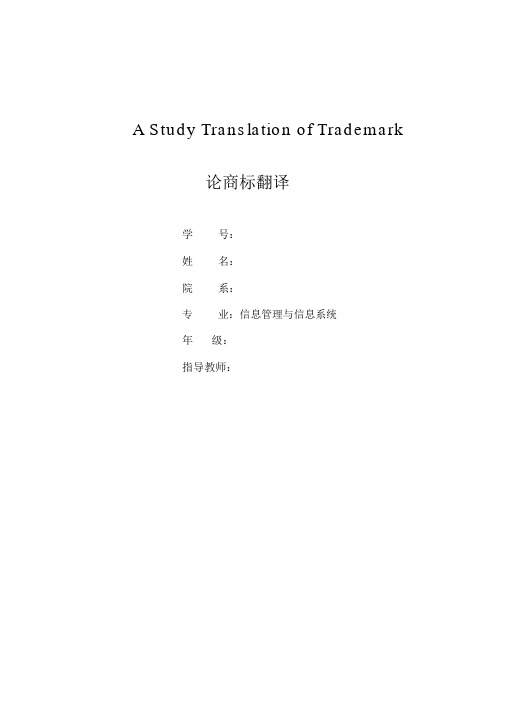
A Study Translation of Trademark论商标翻译学号:姓名:院系:专业:信息管理与信息系统年级:指导教师:CONTENTSINTRODUCTION ⋯⋯⋯⋯⋯⋯⋯⋯⋯⋯⋯⋯⋯⋯⋯⋯⋯⋯⋯CHAPTER ONE Transliteration⋯⋯⋯⋯⋯⋯⋯⋯⋯⋯⋯⋯⋯...1.1 Pure transliteration⋯⋯⋯⋯⋯⋯⋯⋯⋯⋯⋯⋯⋯⋯⋯⋯..1.2 Homophonic translation⋯⋯⋯⋯⋯⋯⋯⋯⋯⋯⋯⋯⋯⋯...1.3 Province transliteration⋯⋯⋯⋯⋯⋯⋯⋯⋯⋯⋯⋯⋯⋯⋯CHAPTER TWO Photo Gallery2.1 P ure Gallery⋯⋯⋯⋯⋯⋯⋯⋯⋯⋯⋯⋯⋯⋯⋯⋯⋯⋯⋯ ..2.2 O ptional Photo Gallery⋯⋯⋯⋯⋯⋯⋯⋯⋯⋯⋯⋯⋯⋯⋯ ..2.3 Change Gallery⋯⋯⋯⋯⋯⋯⋯⋯⋯⋯⋯⋯⋯⋯⋯⋯⋯⋯.. CHAPTER THREE Combination of sound and meaning⋯⋯⋯⋯ ..3.1 Allusive method⋯⋯⋯⋯⋯⋯⋯⋯⋯⋯⋯⋯⋯⋯⋯⋯⋯⋯. 3.2 Almost sound association method⋯⋯⋯⋯⋯⋯⋯⋯⋯⋯⋯ .. 3.3 Almost sound escape method⋯⋯⋯⋯⋯⋯⋯⋯⋯⋯⋯⋯⋯ .. CHAPTER FOUR Sound moral law in recent4.1 Near the sounds meaning⋯⋯⋯⋯⋯⋯⋯⋯⋯⋯⋯⋯⋯⋯⋯ ..4.2 Chromatic semi-defined⋯⋯⋯⋯⋯⋯⋯⋯⋯⋯⋯⋯⋯⋯⋯⋯. CONCLUSION ⋯⋯⋯⋯⋯⋯⋯⋯⋯⋯⋯⋯⋯⋯⋯⋯⋯⋯⋯⋯⋯⋯REFERENCES⋯⋯⋯⋯⋯⋯⋯⋯⋯⋯⋯⋯⋯⋯⋯⋯⋯⋯⋯⋯⋯⋯..摘要商标是一种特殊的语言符号,是商品显着特征的浓缩,也是商品文化的核心部分,同时还是企业参与国际竞争的有力武器。
跨文化交际视角下的商标翻译

Analysis on the Trademark Translation from the Perspective ofIntercultural CommunicationAbstract:As the global communication growing nowadays, the trademark has an important function as the weapon of the enterprises when participating in international competition in the market. Its unique function determines that the translation of trademark words is not only the simple change of two languages, but also the transformation of culture. Good brand names and the internationalization of them play an important role in the process of product sales and brand promotion. Thus a successful translation can help the company improve its brand image among the consumers to a great extent. Researching the trademark is a necessary and urgent task in the current international backdrop. At the same time, the translation of trademark has also been promoted to a new level. Nowadaysthere are still many problems in brand translation, in order to avoid these errors, this paper focuses on summarizing and clear up concretely the method and the way of brand translation by collecting, reading, learning information and comprehending the trademark translation` studing achievement current days under the premise of the cross-cultural communication.To provide a reference for related trademark translation researchers and other people who may have the need.Hoping my paper can do some help for related researchers who study on this theme. Because the trademark translation study is of great significance to help the domestic enterprises to open up and occupy the foreign markets, boost sales and gain the protection of intellectual property. Hope my research can have a positive fuction on not only the points that I have mentioned above,but also on the domestic brands trademark translation, the development of relevant industries in our country, promote economic prosperity etc.Key words:Trademark; internationalization; translation research跨文化交际视角下的商标翻译摘要: 在全球经济交流日益增加的今天,商标作为企业参与国际市场竞争的重要武器具有重要的功能。
12[1].1 商标 品牌 商号翻译
![12[1].1 商标 品牌 商号翻译](https://img.taocdn.com/s3/m/f4fe3f0fff00bed5b9f31d3f.png)
17
世界500强公司(1)
2016/2/24
Business English Translation
18
世界500强公司(2)
2016/2/24
Business English Translation
19
商号翻译方法 英译汉
音译 意译 谐音 增译 减译
Valero Energy Corporation The Royal Bank of Scotland Fuji Xerox Co., Ltd. Ericsson (Sweden)
2016/2/24
壳牌石油公司 中国人寿保险有限 公司 克莱斯勒汽车公司 美国联合航空公司 会计事务所 律师事务所 咨询公司
28
Business English Translation
商号翻译专题 专门性“公司”
Houston Advertising Agency (代理性质的) Agency 公司 Pacific Container Line Line(s) (轮船、航空、 FUJI HEAVY 航运等)公司 INDUSTRIES Industries(实业、工 American Home Products 业)公司 (Corporation) Products(产品)公司
2016/2/24 Business English Translation 3
国内商标品牌
新飞(冰箱) 格力(空调)
中信(银行)
长虹(电视)
2016/2/24
Business English Translation
4
商标的概念
Trademark ™
name, symbol, figure, letter, word, or mark usually registered (Registered trademark)
Unit 6 Translation of tradej marks 商标词的翻译
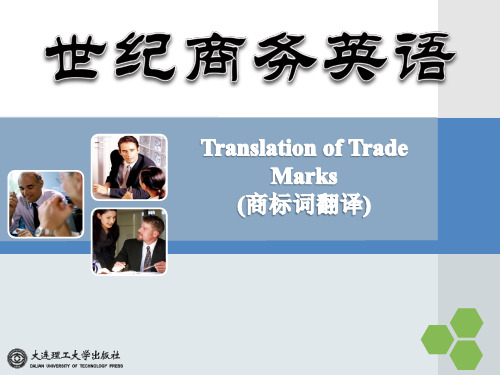
Part II 商标词案例分析
你能发现以上这些商标词的特点吗? 以上这些商标词有一个共同的特点,他们都来源于人名或者地名的专有名词。 人名包括公司创始人或产品发明人的姓氏、姓名全称;神话传说中的人名、影视文 学作品中的人名以及历史名人的姓名。地名包括公司所在地、商品原料产地以及文 学作品或神化传说中的虚构地名。 1,4,7,8,9,10,11,12 试找出以上商标词属于人名商标词的有:_________________________________ 2,3,5,6,13 试找出以上商标词属于地名商标词的有:_________________________________
相似或相对应的内涵。“匹克”既揭示出产品质量优良,又希望奥林匹克运动能
达到最高点;“汰渍”说明洗衣粉泡沫丰富,又暗示这种洗衣粉是一种潮流和趋 势; MAZDA 是拜火教中的光神,松田公司采用这一名称,希望能为汽车工艺带
来光明,虽然翻译而来的中文商标词失去了原商标词的文化内涵,但也为新商标
词赋予了“马”的快速、迅捷的意义联想,符合中国消费者的价值观而为中国消 费者广泛接受和喜爱。 商标词显著的商业功能使它们具有鲜明的语言特点,使得商标词在消费者中 能取得良好的共鸣和认可,达到新颖独特,激发消费者购买欲望的目的。
翻译方法:
商标翻译: 翻译方法: 商标翻译: 翻译方法: 商标翻译: 翻译方法: 商标翻译: 翻译方法:
7.回力牌(运动鞋)
音译结合
LiNing 音译结合 Robust 音译结合 founder 音意结合
8.李宁
9.乐百氏
10. 方正
Part III 单项训练与综合训练
翻译以下商标并分析翻译方法。 商标 6.象牙(香皂) 商标翻译: 商标翻译与方法 Ivory 音译结合 Warrior
trademark translation 商标翻译
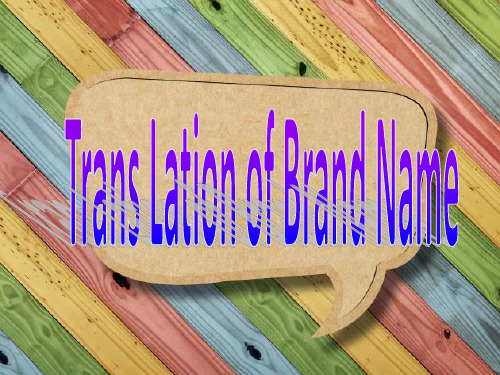
三、free translation
means translating brand names neither
phonetically nor literally..
Goldlion(金利来men’s clothes): if “Goldlion” is translated into “金狮”, it has a homophonic(同音异义) one as “金失”. That is the taboo of factory. They believe that if they use the translated name, the product never be sold well in China. But “金利 来”is a lucky name. It has already been familiar and loved by consumers
二、 literal translation(意译法)
1、 means directly translat of the brand. The advantage is that it conveys the original information of the product.
一、 transliteration (音译法)
means translate the brand names
according to their pronunciation. Swarovski 施华骆世奇 Mazda” as “马自达” “Sony” as “索尼” “Adidas” as “阿迪达斯 “Rolex” as “劳力士” “Haaggen-das” as 哈根达斯
狗不理包子 as Go believe
论文题目

英 语 专业 1999 年级毕业论文(设学号 姓 名 指导教师 论 文 题 目2099001 唐 萍 吕 艳 A Comparative Study of English and Chinese Euphemisms 英汉委婉语对比研究 2099002 郑 梅 雷志敏 Characteristics of English Vocabulary in Advertising 广告英语的词汇特点2099003 杨婷婷 余富林 An Inter-communication View of Words and Their Translation 从跨文化角度看词的文化意义及其翻译 2099004 梅光幸 雷志敏 The Features of Adjective Suffixes 形容词后缀的特征2099005 杨 英 吕 艳 Politeness Principles in English Communication and Pragmatic Failure 英语交际中的礼貌原则和语用失误2099006 李春花 龙纯良 The Comparative Study of Color in Cutural Meaning Between English and Chinese 英语中颜色词的翻译 2099007 周 杰 何敏慧 S trategies for Improving Students’ Listening Abilities 提高学生听力能力之策略2099008 李海燕 阙道彬 Modal Expressions of Adjectives and Adverbs in the Context 英语形容词、副词在语境中的情态表达 2099009 李文英 刘开军 A Comparative Study Between English and Chinese Passive Voice 英汉被动语态cf 比较研究 2099010 李 平 宗乐善 A Comparative study of English and Chinese Onomatopoeia 英汉摹声比较 2099011 陈 英 刘淑芳 Features of Computer English Word-formation 计算机英语的词法特征 2099012 唐 淼 余富林 The Characteristics of Web English 网络英语的特点2099013 谢玉平 吴传凤 Vivid Characters, Deep Impressions – An Analysis of the Characters in Oliver Twist 鲜明的人物,深刻的印象-《雾都孤儿》人物分析2099014 伍平华 莫善清 Analysis of Puritanism Perspectives The Scarlet Letter 红字中的清教主义思想2099015 李建萍 刘淑芳 The notional passive and comparison between English and Chinese 意义被动句及其英汉比较 2099016 黄赛花 刘淑芳 The Forms and Uses of Genitive Nouns of English 英语名词属格的形式和用法 2099017 张 镟 刘肇云 A Comparative of Existential Sentence in English and chinese 英汉存在句对比 2099018 向亚萍 徐明初 The English and Chinese comparison of Rhetoric in Advertisements 英汉广告修辞对比 2099019尹卫玲高绍祥The Referential Function of the Definite Article 定冠词的指涉功能计)清理汇总表学号姓名指导教师论文题目2099020 向延梅吴传凤The Characteristics and Translation of Trademark Words商标英语的特点和翻译2099021 刘彩霞余富林On the Phenomena of Sentence Contraction in English and Chinese Marks论英汉语中的句子紧缩现象2099022 游丽娟刘肇云Functions and Application of English Punctuations英语标点符号的功能及应用2099023 左光辉余富林 A Comparison of Animal Figures in Chinese and English中英有关动物的比喻的比较2099024 彭锦红陈勇The Linguistic Features of Punning Advertisement广告双关语的言语美特点2099025 佘晶丹熊云甫The Image of Tess by Hardy哈代笔下的苔丝形象2099026 李晓靓余富林 A Comparison of English and Chinese Phonetic Ambiguity英汉语音歧义的比较2099027 杨瑜徐明初Translation Techniques of Proverbs and Idioms 谚语和习语的翻译技巧2099028 郑奇陈勇The Choice of Contents and Ways in Translation论翻译的内容与译法的选择2099029 肖清芳陈勇Semantic Abnormality and Rhetorical Collocation in English英语中的语义异常与修辞搭配2099030 刘劲宗乐善The Analysis of Gertrude’s Psychological Description in Sons and Lovers 浅析《儿子与情人》中格鲁德的心理描写2099031 罗秋霞宗乐善The Nature of Metaphor—From the Nature of Metaphor to Its Differences Between English and Chinese 隐喻的本质—从隐喻本质看英汉差别2099032 胡芳刘肇云On the Translation of Trademark Words 浅谈商标词的翻译2099033 唐亚兰吕艳Application of Body Language体态语的应用2099034 龙兰丽何敏慧 A Comparison of the Forms of Plural Nouns between Chinese and English中英名词复数形式的对比2099035 骆娟杨玲The Comparative Study between Metonymy and Metaphor借代与隐喻辞格的比较研究2099036 李丹吕艳The Differences Between British and American English英式英语和美式英语区别2099037 伍华高绍祥Characteristic Language—Analyzing Desdemona’s Charater from the Words 性格语言—从Desdemona 的语言看其性格英语专业1999 年级毕业论文(设计)清理汇总表学号姓名指导教师论文题目2099038 陈岚李钢The Realism in The Adventures of Huckleberry Finn现实主义《哈克贝利·费恩历险记》中的表现2099039 李娟雷志敏 A Comparative Study of the English and Chinese Color Terms英汉颜色词使用的对比研究2099040 王焕相刘开军 A Minor Classification of English Modals and Semi-modals英语助动词与和半助动词之细微分类2099041 陈莹李诗平 A Study of English Active Form With Passive Meaning英语主动形式被动意义研究2099042 章静陈兴An Analysis of Language Features in English Advertisings广告英语的语言特点分析2099043 梅宏娟杨玲Transitional Words and Their Usage论过渡词及其用法2099044 张凤年莫善清The Development of the American Civil Rights Movement in 1960s论美国六十年代民权运动的发展2099045 罗兆毓龙纯良Cultural Factors and Limitations of Translation翻译的文化因素局限性2099046 李丹娄胜平Contest Immersion and Emergence in the Translation of Chinese Poetry into English 汉诗英译中的语境与“融入”和“化入”2099047 卫雁熊云甫On Gray’s Elegy论格雷的《墓畔幽思》2099048 文卓吴传凤Body Language in English Teaching in Middle School中学英语教学中的体态语2099049 王令牛张莉On the Fighting Spirit in The Grapes of Wrath论《愤怒的葡萄》中的斗争精神2099050 毕维陈兴Sexual Discrimination in English 英语中的性别歧视2099051 曹晓燕张杨莉On the Betrayal and Rebellion in Wuthering Heights论《呼啸山庄》中的背叛与反抗2099052 李泽民熊云甫An Analysis of When You are Old评析叶芝各诗《当你老了》2099053 唐华松金泽民Holden’s Confusion, Struggle and S elf-salvation—A P sycho-analysis of the Hero of T he C atcher in the Rye霍尔顿的困惑、抗争与自救——《麦田里的守望者》主人公的心理解析2099054 范胜兰张杨莉A n Analysis of Elizabeth’s Character in Pride and Prejudice对《傲慢与偏见》中伊丽莎白性格的分析2099055 任艳霞吕艳English Idioms and Culture英语习语与文化英语专业1999 年级毕业论文(设计)清理汇总表学号姓名指导教师论文题目2099056 郑剑湘张杨莉The Characterization of Robinson Crusoe 论鲁滨逊的性格塑造2099057 潘叶青牛张莉A Comparative Study of Black Women and White Women’s Social Status in the U.S论美国黑人妇女和白人妇女的社会地位比较2099058 刘炎斌娄胜平The Translation of Indefinite Numerals in English 英语不确定数词的翻译2099059 谢艳丽熊云甫Marfin Eden’s Choice of Death 论马丁伊登的死亡选择2099060 杨红盛海玲On the Use and Translation of “as…as…”论as…as…的用法与翻译2099061 刘定宏牛张莉A C omparative Study of Two Concepts of Privacy and “Ladies First”in China and the Western Count ries 有关隐私和女性优先观念在中国和西方国家的比较研究2189062 何莉牛张莉A Comparative Study of Western China Development and American Westward Expansion 中国西部开发与美国西进运动的比较研究2279063 李洁莫善清The Political Essence of American Economic Aid in Modern Times论新时期美国经济援助的政治内涵2369064 付丽兰牛张莉A Look at the Mass Media of China and Britain Today and its Words Characteristics 浅谈中英大众媒体之现状及词汇特点2459065 蒋春凤刘肇云On English Passive Voice小议被动态2549066 肖江蓠刘开军On the Flexible Use of English Animal Words 浅谈英语动物动词的活用2639067 蔡凤莲娄胜平The Flexibility of the Translation of Chinese Idioms汉语成语英译的灵活性2729068 谭保华熊云甫On Ursula in The Rainbow论《虹》中的厄修拉2819069 戴郁静陈勇Analysis of Ceategorized Context and the Politeness Principle of Lrony 反语的分类语境和礼貌原则浅析2099070 冯丽陈兴On English Color Terms英语颜色词的研究2099071 陈娉婷娄胜平On the Associative Meaning of the Main Color Words小议颜色词的联想意义2099072 尹佳陈兴On the Rhetorical Value of Taboo Words论禁忌语的修辞价值2099073 胡丽妮娄胜平On the Free Translation in the Translation of Idioms 试论习语翻译中的意译英语专业1999 年级毕业论文(设计)清理汇总表学号姓名指导教师论文题目2099074 代利群雷志敏The Infinitive Active in Form and Passive in Meaning 英语不定式主动结构表被动意义2099075 杨翠萍袁妮A Comparison of English and Chinese Proverbs and Their Translation 英汉谚语的比较与翻译2099076 吴丹绮雷志敏A Comparative Study of the “Be” Subjunctive and the Imperative Mood Be型虚拟语气与祈使语气的比较研究2099077 刑剑袁妮Faithfulness in Translation论翻译的忠实性2099078 张碧海熊云甫The Pursuit of Gatzby论盖茨比的追求2099079 李冬华熊云甫C ompson’s Family Tragedy in The Sound and Fury论《喧华与骚动》中康普生家族的悲剧2099081 周琴娄胜平On the Metaphoric Meaning of Colors and Their Translation 论英汉颜色的喻义及其翻译2099082 毛丹张英慧Cultural Differences between English and Chinese Color Words and their Translation 英汉颜色词的文化差异及翻译2099083 易平雷志敏 A Comparative Study of Chinese and English Passive Sentences英汉被动句比较研究2099084 赵静宗乐善On the Interactive Teaching Method交互式教学方法2099085 邵春花杨玲Some Ways of Expressing Implied Negation英语含蓄否定的若干表达方式2099086 伍俊刘淑芳On the Rhetorical Features of English Proverbs论英语谚语的修辞特征2099087 唐媚芬雷志敏On English Noun Modifier论英语名词定语2099088 刘颖颖李诗平 A Comparative Study of Chinese and English Onomatopoeias 中英拟声词对比研究2099089 刘红梅余富林Domestication and Foreignization in the Translation of English Idioms 英语习语翻译的归化与异化2099090 成霞陈勇Differences of Body Language in Cross-Culture Communication跨文化交际中身体语言的差异性2099091 周孟瑜刘开军On English Subjunctive Verb Forms and Their Classifications论英语虚拟语气动词及其分类2099092 张漫红刘开军On the Structure Classification of English Tag Question附加疑问句的分类研究英语专业1999 年级毕业论文(设计)清理汇总表学号姓名指导教师论文题目2099093 陈琼华徐明初On Functions of Semantics and Discourse in There-Existential Sentences 论存在句的语义功能和语篇功能2099094 颜红亮徐明初Study on Vogue-Words论英语中的时髦词2099095 刘玲牛张莉On the Social Value of Gone with the Wind and Scarle tt’s Character论《飘》的社会价值和斯佳丽的人物性格2099096 罗利波牛张莉On the Development of Jane Eyre’s Character试论简爱·性格的发展2099097 洪国旗刘肇云 A Comparison between American Puritanism and New Transcendenlism美国清教主义与超验证主义比较2099098 程艺李诗平 A Tentative Study on English Euphemism浅论英语委婉语2099099 洪芳牛张莉On The Hard-boiled Image in Hemingway’s Works 论海明威作品中的“硬汉”形象2099101 徐佳丽何敏慧On the Art of Rhetorical Devices浅谈广告中英语中修辞的艺术2099102 李红英杨玲On the Rhetorical Structures of Texts 语篇的修辞结构分析2099103 杨石英徐明初On Transferred Epithet and Its Translation浅谈移就修辞及其翻译2099104 陈顺意李诗平The Latest Development of English & Chinese Vocabulary 英汉词汇的新发展2099105 易杨牛张莉The Different Fate of the Two Women Love Defenders—My Comments on Lin Daiyu and Jane Eyre 两个为爱而战的两个女性的不同命运---我看林黛玉和简爱2099106 曾德洁陈勇Cutural Metaphoric Meaning of Food Language in Englsih Colloquialism论英语口语中饮食语言的文化喻义2099107 涂增莫善清Changes of Value in Gone With The Wind《飘》中所体现的价值观念转化赏析2099108 陈英莫善清On Comparison Between ways of Thinking and Value Tendencies of Americans and Chinese论中美思维方式的差异及价值取向之比较2099109 代立高绍祥The lnterpersonal Function in Business Letter商务信函中的人际功能2099110 彭俊高绍祥The Textual Functions of Pre-Predicate That- Clauses That -Clauses前置的语篇功能2099111 王文升宗乐善Female Characters As Spiritual Educate In Spenser’s The Faerie Queene斯宾塞《仙后》中作为精神教育家的女性英语专业1999 年级毕业论文(设计)清理汇总表学号姓名指导教师论文题目2099112 付依娜陈兴Symbolism in Idiomatic Expressions习语的象征意义2099113 黄亦贵刘淑芳On the Main Differences between American English and British English 美式英语与英式英语的差异2099114 孙艳高绍祥On the Semantic and Pragmatic Meaning of Utterance论话语的字面意义和语用意义2099115 曹云辉徐明初Translation Skills of Culture-loaded Words—On“Setected stories of LuXun” 文化员找词汇的翻译方法和技巧——《鲁迅小说选》英译谈2099116 定莹张杨莉On the Image of Women in Jan Eyre论《简爱》中的女性形象2099117 袁琦刘淑芳A n Analysis of the Part of Speech of “As” and Its Uses As的词性与用法分析2099118 裴静余富林The Translation of the Passive Voice in EST 科技英语被动语态的翻译2099119 彭云佳阙道彬The Useage of Articles冠词的用法2099120 徐欣张杨莉Wordswort h’s View on Nature and Life 论华兹华斯的自然观及人生观2099121 易玲陈兴Mastering the Studying Law of Children’s Language Learning and Promoting the Second Language Acquisition 掌握儿童语言学习规律,促进二语习得2099122 杨薇娄胜平Advertisement Translation广告的翻译2099123 张家武刘开军Some Aspects of Articles in English Study英语冠词学习要点2099124 谭智凤吴传凤The Comparison between English and Chinese Nonce Words英汉仿词比较2099125 张志华牛张莉O n the Creation of Characters in Dicken’s A Tale of Two Cities论狄更斯《双城记》中的人物塑造2099126 郑曼陈勇On Similarities and Differences in the Formation English and Chinese 浅谈英汉仿词在构成形式上的异同2099127 万前珍吴传凤Love Always Overcomes Hatred爱总能战胜恨2099128 杨丛李诗平The Characteristics of American English美国英语的语言特点2099129 陈丽娟盛海玲Aanalysis on the Chineses Borrowings in English 英语中汉语借词探析英语专业1999 年级毕业论文(设计)清理汇总表学号姓名指导教师论文题目2099130 刘美华张杨莉The Rhetoric in The Merchant of Venice论《威尼斯商人》中的修辞现象2099131 蒋英杰高绍祥The Textual Function of Passive Voice论被动语态的语篇功能2099132 金燕飞陈兴Features of Network English网络英语的特点2099133 袁涛吴传凤The Use of Body Language in Middle Schools中学英语教学中体态语言的运用2099134 刘茵莫善清A Comparison Between American and Chinese Higher Education in the 21st Century 二十一世纪中美高等教育之比较2099135 杨小芳余富林The Use of the Comma and the dash in EST科技英语中逗号与破折号的用法2099136 姜建华雷志敏On Phenomena of Sexism in English 英语中的性别歧视现象2099137 王华平盛海玲On the Transferred Negation in English浅析英语中的否定转移2099139 段岚龙纯良On How to Translation of the Chinese Reduplicated Words into English汉语叠词英译2099140 张警方阙道彬The Classification and translation of English Idiom Preposition英语成语介词的分类及翻译2099141 金佳宗乐善On Hardy’s Fatalism in Tess论《苔丝》中哈代的宿命论2099142 韩飞岸刘淑芳The Features and Origin of French Borrowings in English英语中法语外来词的特点及由来2099143 姚燕群张英慧Symbolism of Colors in idomatic Expressions颜色习语表达的象征意义2099144 黄书何敏慧The Difference of Styles in Translation 翻译中的文体差异2099145 江友君余富林On the Translation of Noun Phrases in EST科技英语名词术语的译法初探2099146 王湘艳熊云甫Tess’ Sense of Responsibility苔丝的责任心2099147 彭术连何敏慧Teacher’s Roles in Class教师在课堂中的角色2099148 胡小玲张英慧On Euphemistic Expressions in English论英语中的委婉表达法英语专业1999 年级毕业论文(设计)清理汇总表学号姓名指导教师论文题目2099149 熊梅何敏慧The Nominalization and Grammatical Metaphor英汉名词化和语法隐喻2099150 侯海英徐明初The Structures and Characteristics of English Simile and Metaphor 英语中的比喻结构的特征2099151 赵禹熊云甫Humanitarianism in A Tale of Two Cities《双城记》中的人道主义思想2099152 刘亦伶何敏慧On Satire and Humor in Pride and Prejudice浅析《傲慢与偏见》中的讽刺与幽默2099153 彭娟李诗平English Phrasal Verbs论英语短语动词2099154 印晓蕾刘肇云Cultural Difference of English—Chinese Idioms and Its Translation英汉习语的文化差异与翻译2099155 唐琳吕艳On English Rhetorical Elliptical Sentences英语修辞省略句2099156 刘怡君刘肇云Communication Failures Appeared in Intercultural Communication论跨文化交际中的语用失误2099157 钱晓静杨玲On Zeugma’s Rhetorical Effect and Translation浅析轭式搭配的修辞效果与翻译2099158 李永红徐明初 A Comparative Study on Oxymoron and Duiding英语矛盾修辞比较研究2099159 姚维余富林The Translation of Long Sentences in EST科技英语的长句翻译2099160 刘园园余富林The Differences and Application of Chinese and English Palindrome中英回文辞格的发展差异与应用2099161 曾欢张杨莉Lolita, the Tragedy of Pedophilia《诺莉塔》:恋童癖的悲剧2099162 艾华香熊云甫S arah’s Way to Freedom萨拉的自由之路2099163 陈雪张杨莉Jane Eyre’s Sense of Interiority简爱的自卑感2099164 彭翔高绍祥Coherence in Interpretation of Discourse论语篇翻译中的连贯2099165 刘琢徐明初Influence of Cultural Differences on Translation 文化差异对翻译的影响2099166 张欣子盛海玲On the Form of Emphasis in English 英语中的强调的表达形式英语专业1999 年级毕业论文(设计)清理汇总表学号姓名指导教师论文题目2099167 刘婉萍袁妮On Translation of English New Words论英语新词的翻译2099168 欧勇刘开军A Brief Exploration of Lexical Ambiguity in English and Its Pragmatic Effects Words 浅谈英语词汇的歧义与语用效果2099169 陆晓红娄胜平On Ellipsis论省略2099170 朱兰红余富林The Cultural differences and translation of English and Chinese idioms 英汉习语与文化差异的翻译2099171 高艳琴张英慧On Emphatic Patterns in English英语中的强调形式研究2099172 田薇琪徐明初On Chinglish in Chinese-English Translation中英翻译的中式英文2099173 田湘群徐明初Elementary Analysis of Translating Attributive Clause浅析定语从句的翻译2099174 胡秋明刘开军 A Brief Research on the English Infinitive Structure英语不定式初探与研究2099175 唐冰芳陈勇English Words Sanantic Variattion and the Society英语词汇语义变化与社会的关系2099176 昌佩仙熊云甫On the Symbolism in Blake’s Poems论布莱克诗歌中的象征主义2099177 许剑凤张英慧Some Ways of Expressing Implied Negation in English英语含蓄否定表达法种种2099178 梁怡君吴传凤On Franslation of Trademarks and Names of Export Commodities论商标、出口商品名称的翻译2099179 周菡盛海玲 A Brief Introduction to Grammatical Ambiguity in English浅谈英语中的语法歧义现象2099180 伍海英余富林On the Basic methods and skills of translation of Business English Terms 商务英语词汇翻译常用方法与技巧初探2099181 刘金娥高绍祥The Functions of Pre-Posed Infinitive clauses不定式分句前置的使用功能2099182 田芝盛海玲On The Borrowed Elements in the English Vocabulary 浅谈英语词汇中的外来成份2099183 吴红梅宗乐善English Synonyms and Vocabulary Enlargement英语同义词及词汇扩展2099184 傅亚辉吕艳On the Use of Euphemisms in The Daily Life浅议委婉语在日常生活中的运用英语专业1999 年级毕业论文(设计)清理汇总表学号姓名指导教师论文题目2099185 杨才有徐明初Parody in advertisement A study on Translation广告中的仿似现象探悉2099186 戴杏花盛海玲On the Semantic Function and Usage of the Conjunction “and”连词“and”的语义功能与用法2099187 刘桂郴徐明初A BriefTalk on Differences and Translatability of English and Chinese Idioms 浅析英汉习语的文化差异及其可译性2099188 叶荣兴宗乐善On Steps of Learning English 英语学习步骤浅议2099189 刘忆平张英慧 A Comparative Study of Ambiguity and Pun in English英语中歧义与双关的对比研究2099190 鲁亚丽何敏慧Slangs about Vegetables & Fruits in English and Their Uses英语中有关蔬菜和水果的俚语及其运用2099191 赵生群刘开军On Absolute Nomination Construction浅析独立主格结构2099192 何乐吴传凤 A Balanced Approach to Oral English Teaching英语口语教学平衡方法2099193 李艳刘开军On the Verb Forms of English Subjective Mood浅谈英语虚拟语气的动词形式2099194 尹晔玲李诗平 A Contrastive Study on English and Chinese Idioms 英中习语对比2099195 石子娟袁妮On Translation of English Allusion英语典故的翻译2099196 文芬高绍祥 A Constrastive Analysis of Euphemism Between Chinese and English中英委婉语的对比分析2099197 向淑敏陈兴On the Fuzziness and Vagueness of Language 论语言的模糊与含糊2099198 陈兰龙纯良Refle ctions on Animals in and out of China从国内外的动物说起2099199 徐颖刘肇云Translation Techniques of Chinese Idioms汉语成语的翻译技巧2099201 李召军徐明初Idioms and Features of Idioms习语及其习语特征2099202 孙慧李诗平 A Comparative Study on the English and the Chinese Metaphor英汉隐喻对比研究2099203 石娜杨玲A Comparative Study of Euphemism and Fuzzy Language in English and Chinese委婉语与模糊语中英对比研究英语专业1999 年级毕业论文(设计)清理汇总表学号姓名指导教师论文题目2099204 卜成芳盛海玲On Idioms Used in Colloquial English论习语在英语口语中的使用2099205 涂少芳张英慧 A Probe into the Feminist Idea of Jane Eyre简·爱女权主义思想初探2099206 胡丰龙纯良Translation of the Peculiar Speech of Each Participant in the Conversation 论小说个性语言翻译2099207 文慧红阙道彬On the Cognition and Usage of Metaphor论隐喻的认知及其运用2099208 彭慧玲雷志敏The Classification of Metaphor隐喻的分类2099209 程竹玲阙道彬On the Types and Uses of the Passive Voice论英语被动语态的类型及用法2099210 夏金锦刘开军 A Detailed Study on THERE in English Existential Sentence试论英语存在句结构中的引导词THERE 2099211 傅诺诚何敏慧The Differences of Rhythm between Chinese and English英汉节奏差异2099212 杨见清阙道彬On The Usage of “T hat”论“That”的用法2099213 李玲何敏慧The Exploration of Oral English Teaching Methodology英语口语教学法探讨2099214 李志文龙纯良To Cultural Difference between English and Chinese Idioms and Their Translation 浅谈英汉习语的文化差异及翻译2099215 赵娟鹃刘淑芳On Feminism in Pride and Prejudice试论《傲慢与偏见》中的女权意识2099216 舒丽颖何敏慧Appropriate Use of Body Language in Spoken English Teaching 英语口语教学中体态语的适当使用2099217 文慧袁妮On Translation of Trade Marks论商标的翻译2099218 洪林阙道彬The Rhetoric in Advertising English广告英语中的修辞2099219 杨艳莫善清The Hegemonic Nature of Unilateralism of the Bush Administration’s Foreign Policy 布什政府外交政策单边主义的霸权主义实质2099220 李凤娟徐明初The Linguistic Characteristics of Business English and Its Translation 商务英语的语言特点及翻译刍义2099221 谭静刘淑芳On the Borrowed Words in English英语中的外来词英语专业1999 年级毕业论文(设计)清理汇总表学号姓名指导教师论文题目2099222 刘桂花李诗平Color Words in English英语中的颜色词研究2099223 周辉龙纯良The Existence and adaptation of Untranslatable From不可译现象的存在和转化2099224 刘莉英陈兴The Tense-Aspect System of English Grammar-Forms and Meanings英语语法中的时体体系:形式和意义2099225 石亚娟陈兴On Vague Terms in Everyday Spoken English论英语日常口语中的模糊词语2099226 谢艳泓徐明初A Tentative Study on the Translation of Adverbial English Dallses in Clause 英语状语从句汉译初探2099227 林池容杨玲Euphemism and Its use in Translation 委婉语及其在翻译中的使用2099228 蒋丹刘淑芳The Communicative Functions of Euphemism委婉语的交际功能2099229 胡焱平阙道彬On the Usage of “It”“It”的用法2099230 李红阙道彬On English Linguistic Taboos论英语语言的禁忌2099231 雷彩云阙道彬 A Tentative Analysis of English Color Words探英语中的颜色词2099232 雷国红李诗平On English Siamese Twins 英语成对词词组初探2099233 谭林池李诗平On English Elliptical Sentence英语省略句2099234 邓晖吕艳The Characteristics of Attributes in English英语定语之我见2099235 道霞李钢Feminism in Jane Eyre论女权主义在简爱中的体现2099236 左欢袁妮The Translation of Idioms 谈习语翻译2099237 李彦妮牛张莉 A Comparative Study of Chinese Jokes and Western Humor中国笑话和西方幽默2099238 李小红张英慧Cultural Differences in English and Chinese Everyday Conversation中英日常会语中的文化差异2099239 游菲菲盛海玲The Form and Function of the Euphemism英语委婉语的构成及其功能英语专业1999 年级毕业论文(设计)清理汇总表学号姓名指导教师论文题目2099240 李子祥莫善清O n the Pessimistic Fendencies in Hemingway’s later works试论海明威后期中作品中的颓废主义倾向2099241 彭旭娟龙纯良On the Cultural Differences between Chinese—English Translation论中英翻译中的文化差异2099242 陈昊袁妮On Translation of English of Colour Words论颜色词的翻译2099243 韩雨飞盛海玲An Analysis of the Usage of Infinitive in English不定式的用法剖析2099244 王燕袁妮Culture Differences and Translation文化差异与翻译2099245 田津雷志敏The cultural Connotation and Expressive Technique of Euphemism委婉语的文化内涵和表现手法2099246 雷文君杨玲 A Comparative Study of “Pun” and “Shuangguan”“Pun”与“双关”的比较研究2099247 刘奕兵阙道彬English from Sexism to Neutralization英语中的性别歧视与中性化。
Lecture Nine 商标、商号的翻译(1)

• • • • •
三、英文商标的命名和构成特点 英文商标词的主要来源有: 专有名词 普通词汇 臆造词汇
Section 1 Definition and Function of the Trademark and Constitutive Characteristics of the English Trademark
• • • • • • •
《辞海》 给出的定义是: 商标是企业、事业单位或个体工商业者对 其生产、制造、加工、拣选或经销的商品 所使用的标志。一般用文字、图形或其组 合,注明在商品、商品包装、招牌、广告 上面。
Section 1 Definition and Function of the Trademark and Constitutive Characteristics of the English Trademark
• • • • • •
(三) 联想产品的功能 作为标识符号 商标所传递的信息是丰富的 信息之一便是 让消费者一看到商标就能很自然地联想到 它所代表的是什么产品
Section 1 Definition and Function of the Trademark and Constitutive Characteristics of the English Trademark
• • • • • • •
二、商标的功能 商品的商标 代表商品的符号 商标的设计 在企业市场营销战略中占举足轻重 一种知识产权 一种无形资产
Section 1 Definition and Function of the Trademark and Constitutive Characteristics of the English Trademark
中文商标的英译
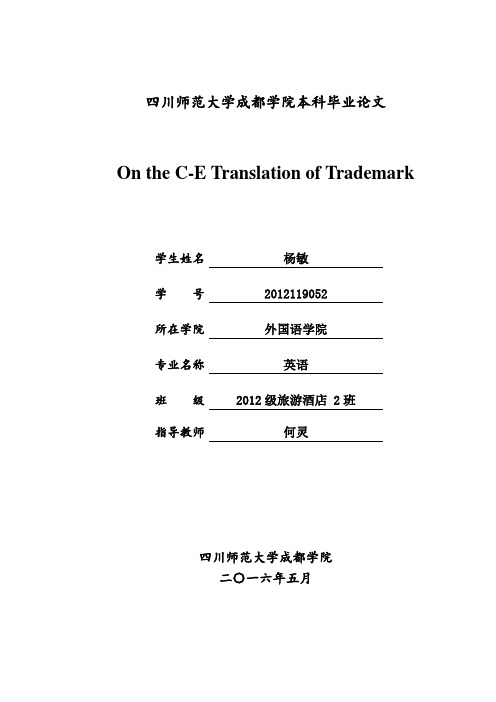
四川师范大学成都学院本科毕业论文On the C-E Translation of Trademark学生姓名杨敏学号2012119052所在学院外国语学院专业名称英语班级2012级旅游酒店 2班指导教师何灵四川师范大学成都学院二〇一六年五月On the C-E Translation of TrademarkAbstract: At present, Chin a's GDP has ranked the world’s second place and China has become a genuine giant both in economy and trade. With the development of economic globalization, trademarks are also slowly going to abroad. In particular, since entered to the WTO, our products have been out of the country but to the world. Among them, the trademark’s contribution to China’s economic development is essential. Therefore, the trademark translation is particularly important. It should not only have Chinese characteristics, but also it should be loved by consumers. Trademarks and brands represent the corporate image which is one of the intangible assets and wealth. A good name can leave a good impression on customers, which add appealing charm to the product. This paper mainly introduces the definition, characteristics and functions of the trademark and trademark translation methods. Translation methods can be divided into Transliteration, Literal translation, Free translation, Combination of Transliteration and Free Translation which can illustrate the importance of trademark translation. Producers can also increase interest in the success of the brand and make the world fall in love with the products which are made in China.Key words: trademarks translation methods strategies中文商标的英译学生:杨敏指导教师:何灵内容摘要:目前,中国的国内生产总值已位居世界第二,无论是在经济还是在贸易上,中国已成为一个真正的巨人。
商标的汉英翻译

飘柔 Rejoice;雅戈尔 Youngor
Thursday, January 30, 2020
English College
沿用
有些外国公司,特别是一些老牌的知名公司, 其汉语译名一般沿用约定俗成的译名来翻译, 尽管有时译名与原名差距较大。
商标的汉英翻译
Chinese-English Translation of Trademark
Thursday, January 30, 2020
English College
关于商标
商标及商标语言
商标是商品的标志,是表明一种商品与其他 商品相区别而采取的任何文字、图形、符号 、设计或其他组合;是代表商品质量、性能 、技术水平和其他特征的一种标志。
练习一
“黑旋风”(杀虫剂) “捷安特”(自行车) “鹅牌”(袜子) “四通”(电脑公司) “海飞丝”(洗发露) “现代”(汽车)
Thursday, January 30, 2020
English College
练习二
二十五岁时,交换是情侣手中相同款式的戒指。
“你愿意娶她为你的合法妻子,无论疾病、
红豆——Hongdou 海信——Hisense; 雅戈尔——Youngor
Thursday, January 30, 2020
English College
直译
有些商标名称可以直译,既简便,有能够保留 原商标的语言美。
熊猫——Panda; 小熊猫?? 大白兔——White Rabbit 长城——The Great Wall 直译须谨慎,要避免掉入“文化陷阱”。实或虚构的)专有名词
目的论视角下英文商标词的翻译
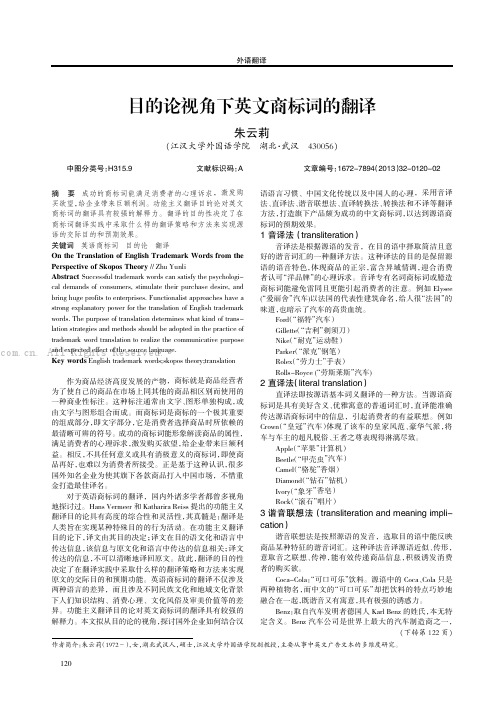
(下转第122页)摘要成功的商标词能满足消费者的心理诉求,激发购买欲望,给企业带来巨额利润。
功能主义翻译目的论对英文商标词的翻译具有较强的解释力。
翻译的目的性决定了在商标词翻译实践中采取什么样的翻译策略和方法来实现源语的交际目的和预期效果。
关键词英语商标词目的论翻译On the Translation of English Trademark Words from thePerspective of Skopos Theory //Zhu Yunli Abstract Successful trademark words can satisfy the psychologi-cal demands of consumers,stimulate their purchase desire,and bring huge profits to enterprises.Functionalist approaches have a strong explanatory power for the translation of English trademark words.The purpose of translation determines what kind of trans-lation strategies and methods should be adopted in the practice of trademark word translation to realize the communicative purpose and expected effect of the source language.Key words English trademark words;skopos theory;translation 作为商品经济高度发展的产物,商标就是商品经营者为了使自己的商品在市场上同其他的商品相区别而使用的一种商业性标注。
商标业内常用词汇对应英文完全性指北
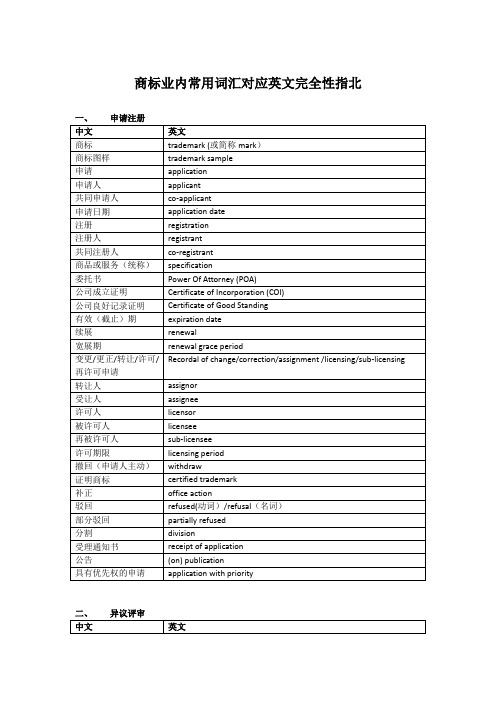
裁定
official decision
三、其他
中文
英文
诉讼
court appeal; litigation
侵权
infringement
(一/二)审
(First/Second) instances
代理方
representing agent
第三方
third party
复审商标
appealed trademark/reviewed trademark(须与上者保持一致)
复审商品
Appealed goods/reviewed goods(须与上者保持一致)
无效宣告
declaration of invalidation
争议商标
conflicted trademark
撤销
probative force
真实意图
bona fide intent
商标淡化
trademarkdilution
同意书
Consent Letter
工商查处
AIC raid
初步证据
prima facie evidence
再审
retrial
提审
bring…for trial
类似商品或服务区分表
Classification Table of Similar Goods and Services
受理通知书
receipt of application
公告
(on) publication
具有优先权的申请
applicationwith priority
二、异议评审
中文
中英文商标的命名与翻译
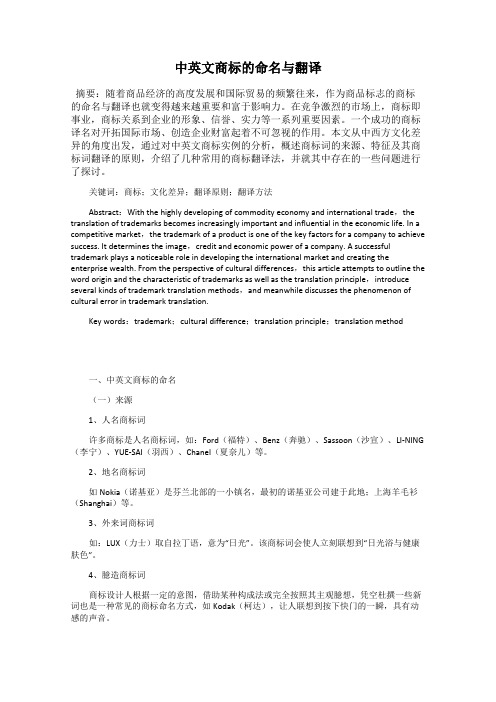
中英文商标的命名与翻译摘要:随着商品经济的高度发展和国际贸易的频繁往来,作为商品标志的商标的命名与翻译也就变得越来越重要和富于影响力。
在竞争激烈的市场上,商标即事业,商标关系到企业的形象、信誉、实力等一系列重要因素。
一个成功的商标译名对开拓国际市场、创造企业财富起着不可忽视的作用。
本文从中西方文化差异的角度出发,通过对中英文商标实例的分析,概述商标词的来源、特征及其商标词翻译的原则,介绍了几种常用的商标翻译法,并就其中存在的一些问题进行了探讨。
关键词:商标;文化差异;翻译原则;翻译方法Abstract:With the highly developing of commodity economy and international trade,the translation of trademarks becomes increasingly important and influential in the economic life. In a competitive market,the trademark of a product is one of the key factors for a company to achieve success. It determines the image,credit and economic power of a company. A successful trademark plays a noticeable role in developing the international market and creating the enterprise wealth. From the perspective of cultural differences,this article attempts to outline the word origin and the characteristic of trademarks as well as the translation principle,introduce several kinds of trademark translation methods,and meanwhile discusses the phenomenon of cultural error in trademark translation.Key words:trademark;cultural difference;translation principle;translation method一、中英文商标的命名(一)来源1、人名商标词许多商标是人名商标词,如:Ford(福特)、Benz(奔驰)、Sassoon(沙宣)、LI-NING (李宁)、YUE-SAI(羽西)、Chanel(夏奈儿)等。
- 1、下载文档前请自行甄别文档内容的完整性,平台不提供额外的编辑、内容补充、找答案等附加服务。
- 2、"仅部分预览"的文档,不可在线预览部分如存在完整性等问题,可反馈申请退款(可完整预览的文档不适用该条件!)。
- 3、如文档侵犯您的权益,请联系客服反馈,我们会尽快为您处理(人工客服工作时间:9:00-18:30)。
Translation of TrademarkCONTENTS Abstract (i)摘要 (ii)1 Introduction (1)2 The theory of functional equivalence (2)3 The sources and characteristics of trademark (3)3.1 The sources of trademark (3)3.1.1 Name-related trademark (4)3.1.2 Geographical name trademark (4)3.1.3 Exotic trademark (5)3.1.4 Fabricated trademark (5)3.2 The characteristics of trademark (6)3.2.1 Loyalty (6)3.2.2 Symbolic meaning (6)3.2.3 Advantageous remembrance (7)3.2.4 Clarity and coherence (7)4 Fundamental values in trademark translation (7)4.1 Information value (8)4.2 Cultural value (8)4.3 Appreciation value (8)4.4 Commercial value (9)5 Fundamental methods in trademark translation (10)5.1 Transliteration (10)5.2 Literal translation (11)5.3 Free translation (11)5.4 Additional translation (11)6 Conclusion (13)Bibliography (15)Acknowledgements (16)ABSTRACTWith the development of globalization, more and more products from China are walking into the international market. The name of trademark is of great importance in the image of a brand, so trademark translation is the fundamental task to build a worldwide brand. As a result, trademark translation seems even more urgent and important. A good trademark should be fluent to read, refreshing to see and easy to remember. The different characteristics of different language and the existence of different cultures make translation a recreation process. This paper firstly introduces the theory of Nada’s functional equivalence, and then analyzes the sources and characteristics of trademark; in addition, four basic standards should be followed in translation. They are information value, cultural value, appreciation value and commercial value. Finally this paper proposes four essential translating methods in trademark translation. They are transliteration, literal translation, free translation and additional translation. Therefore, in order to express a good trademark the four basic standards should be obeyed and the four basic translating methods should also be applied. In this way, the goal of attracting consumers will be realized as quick as possible.Key words: trademark; translation methods; value摘要随着全球化的进程加快,越来越多的中国产品进入国际市场。
商标名称是树立品牌形象的重要内容,做好商标名称的翻译工作则是树立全球品牌形象的首要任务,因而商标的翻译工作显得尤为紧迫和重要,一个好的商标应该做到朗朗上口,清新优美和便于记忆。
不同特点及民族文化差异的存在使得商标翻译必然成为一个再创造的过程。
本文以奈达的功能对等理论为基础,通过对商标名称的来源及特点进行分析,进而提出了翻译过程中需要体现的四项基本价值,即:信息价值,审美价值,文化价值和商业价值。
最后,文章阐述了商标名称翻译的四种方法,即音译、直译、意译和增译。
因此,一个好的商标在翻译的过程中要依据以上四项基本价值,运用恰当的翻译方法,来达到其吸引顾客的目的。
关键词:商标;翻译方法;价值1. IntroductionWith the incessant increasing of the multi-international commodity trade, trademarks become more and more international, especially in the modern society of economic globalization, for opening up overseas market and setting up the whole world of brand of image, more and more enterprises attach importance to trademark translation, to help a commodity to find a foothold in the marketplace. Being one kind of important means of promotion and instrument in marketing and sales, the trademark, has an important effect on achieving the goal of enterprise. Every trademark implies its cultural connotation, the producing and accepting of a trademark is actually the process of intercultural communication. The effect of communication depends on how the trademark is translated.Trademark is the name of products, the agent of brand image. The quality of a trademark good or bad, being widely accepted by public or not, can not completely influence the future of the products and the fate of companies, but it will have a major impact on the product. Trademarks always determine the success or failure of the product. In modern information society, particularly in nowadays when China is developing international trade and economic relations, trademarks take on a dual mission of economics and cultures, and play a great role. And in which translation of trademark occupied the position that can not be ignored. Therefore, translation of trademark becomes an important and meaningful work. Concerning this, how to translate a trademark good, appears to be very crucial.Unlike little variety of products was available of the past,now the market provides a feast for p eople’s eyes with various commodities. Facing so many choices,the consumers naturally consider not only quality but also other factors. Before buying things,people cannot help questioning: “Will the quality be good since its trademark is so ordinary? What’s this commodity for since the meaning of name is vague? Who are willing to buy this as it sounds bad and possesses inauspicious meaning?" Everyone would like to buy things with both trustable quality and distinctive trademark which can satisfy the consumers' psychology of good wish and stimulatetheir desire to buy it. Although many people think that only the quality of products is important to the sales in the international market, successful translation of trademark as well as trademark itself is more necessary to attract consumers and make higher sales.2. The theory of functional equivalenceNida put up with “functional equivalence” to replace “dynamic equivalence” in the book The theory and practice of translation, which coauthored with Charles Tabor in 1969.He explained:Translating means communicating, and this process depends on what is received by persons’ hearing or reading a translation. Judging the validity of a translation can not stop with a comparison of corresponding lexical meanings, grammatical classes, and rhetorical devices. What is important is the extent to which receptors correctly understands and appreciates the translated text. Accordingly, it is essential that functional equivalence be stated primarily in terms of a comparison of the way in which the original receptors understood and appreciated the text and the way in which receptors of the translated text understand and appreciate the translated text (P116).Someone may hold the view that functional equivalence translation is a kind of translation that is not accurate for its deviating from the original in style. However, the accusation of functional equivalence translation in this reason equals to the explanation of “accurate” in a strict way. If you want to have the exact meaning of “accurate”,you must rely on the fact that either the reader in target language or in original language can give a basically identical response to the accepted information. That is to say it is the functional equivalence translation that makes the readers in different languages gives a basically identical response. If you can understand the word “accurate” in this way, it is no doubt that functional equivalence translation not only can make the translation work easily understood by readers, but much more accurate.Nida considered that translation serves for the ordinary readers or the languageembracers. The evaluation of the translation work must combine with readers’ reaction. As well as the contrast between the above reaction and the reaction the authorship to original work. General speaking, these two reactions mentioned above indicate that whether the translation work can get a satisfied result in evaluation. It is request that translation work should make readers and authorship give a basically identical reactions not an exactly identical reactions in dynamic equivalence translation since various differences exist between original language and target language ranging from culture to historical background.The so-called functional equivalence refers to the original language speakers have the roughly same feeling with the target language speaker when they accept information. In other words, translators must try their best to reconstruct the original la nguage information with the method “cultural equivalence” in semantic and stylistic. What’s more,translators should not pay attention to original words’ linguistic structure or formal correspondence but original words’ meaning and connotation in the proce ss of translation. If you want to realize “functional equivalence” in trademark translation, these following tips should be highly emphasized: first, customer is God. As a kind of popular and influential artistic form, trademark translation should be based on consumer’s appreciation ability and easily acceptable verbalism. Second, translators should take advantage of translated language and objectively functional equivalence. In view of the existence of cultural differences between original language and target language, mechanical form equivalence is able to make vivid trademarks in original language become meaningless in translated language. If translators want to realize the functional equivalence in trademark, they must take advantage of translated language to make reconstruction. The final purpose of trademark translation is using the most ordinary language style and approximately cultural equivalence to translate the original trademark so as to cause the similar reaction between the consumers in both translated language and original language. 3. The sources and characteristics of trademark3.1 The sources of trademarkThe sources of goods always are associated with the founder of the enterprise and its birthplace. Different commodities have different connotations because of different geographical and cultural conditions. The combination and understanding of goods is a right way and a prerequisite for the translation of trademark. Throughout the forms of trademarks, trademark names can be named according to people’s names, names of places, exotic names and fabrication.3.1.1 Name-related trademarkTrademarks named after enterprises, the founder of the company, product or invention patent holders is the international norm. Such as Ford(福特), Benz (奔驰), Cadbury (吉百利), Sassoon (沙宣), Li Ning (李宁), the famous car “Audi”is translated into“奥迪”, “Cadillac”is“卡迪拉克”in Chinese, “Ford”is“福特”.Those translated names often do not have special meaning, but they keep and express the style of the original ones. In addition, they can reflect foreign culture by transliteration. When named trademarks, sometimes, names of gods from myths and legends are also chosen, or names from literature, film and television works, such as NIKE (耐克) is a victory of the goddess of Greek mythology, ANGEL (安琪儿) refers to the messenger sent by God. Another kind is word trademark which applies ordinary words to make people easily associate with the product because most words have figurative meaning. Therefore, to those trademarks, the normal way is to translate literally so that it will stimulate the consumption because of good association to be reminded whenever consumers see this product. Literal translation can keep the characteristic of the original names, and directly and accurately express the information that original ones intend to. For instance, Apple, as a trademark of computer, is translated literally into“苹果”. This name sounds very cordial and close to buyers and it's proved that “Apple” does sell well.3.1.2 Geographical names trademarkTo name a trademark according to its birthplace is often widely used as an important means. For example, luxury hotels Shangri-la (香格里拉) from the well-known British writer James Hilton’s literary works, “Lost Horizons”in the fictitious names, its original site is in the territory of Yunnan Province in China, it ispermanent year-round spring, a beautiful area and a desirable “ideal world”. Another example Cashmere (开斯米) is named after the place Cashmere, NOKIA (诺基亚) is a small town in northern Finland, and the first Nokia was built here. These are: Champagne (香槟) from the French champagne named after the place of production; Tsingtao Brewery (青岛啤酒); Shanghai Sweater (上海羊毛衫), and so on.3.1.3 Exotic trademarkTrademark term from foreign words is the result of different cultures exchange, such as LUX (力士) from the Latin, meaning “daylight”. The trademark leads people to connect “sun and a healthy color” immediately. Another example shampoo (香波) from the Hindi Campo, which means “massage”. The term specifically refers to shampoo, refers to shampoo in the right direction: gently knead by hand, at the same time massage on the scalp. In the eighteenth century, British colonialists invaded India, brought this word in English, written in Shampoo. SONY(索尼) derived from the Latin Sonus, which means “voice”.3.1.4 Fabricated trademarkTrademarks designed according to certain intentions, with some accordance and subjective imagination is an important way to name trademarks. Those words that are invented to express some information according to certain principles and intentions, attains the largest proportion in vocabulary of trademark. The construction of those words normally concerns several fields such as marketing, industrial design and psychology since the word-formation is various, translators must flexibly interpret. For these words, transliteration is still one way, but it must be accompanied with other means such as literal translation or paraphrase. Take “Bubble Yum” for example, Yum originally means “tasty”, and here is paraphrased into “百宝”(meaning treasure). Moreover, it sounds similar to “Bubble”. Added with the literal meaning of bubble(泡泡糖),the final translation appears as “百宝泡泡糖”,In this way, it's more vivid for consumers to have knowledge of this brand and more able to guide consumption. Another example is Kodak (柯达), the mark reminds us of the moment to press the shutter with a dynamic voice; Haier (海尔) has a similar voice with the English word“higher”, which means higher and better; Supor (苏泊尔) has a similar voice with the English word “super”, which means excellent.3.2 The characteristics of trademarkThe trademark of commodity stands for a kind of commodity, just as one’s name, and enjoys a widespread reputation, with the ceaseless expansion of the commodity exchange: many famous trademarks in the world have already become the intangible assets and enormous wealth of enterprises. These successful brand names have something in common as follows.3.2.1 LoyaltyMany trademarks have some connections with the goods themselves more or less, than often be reflected on their denotations. For example, “京客隆” (the trademark of a chain supermarket in Beijing), first it reflected the location of its headquarters, then “客隆” shows that it is a walk of service, only there are quite a few of guests, it would be very profitable. Another example, “Ivory” is a kind soap, it demonstrates the purity of the products, and can make the clothes clean just like the quality of “ivory”. The trademark “Li Ning”(李宁) is designed according to its first Chinese Pinyin formation. “L” and “N” is colored in red printed; it is beautiful, modern and energetic. It fully contains the spirit of sports. What is more, the trademark represents the flying flag, the burning torch of youth and energy. Another example, the trademark “Wal-Mart”(沃尔玛), “mart” has a meaning of “market”, this helps customers know clearly the selling scope of this brand.3.2.2 Symbolic meaningFor example, the noted male finery brand “Goldlion”, English meaning is “a golden lion”, the translator is to make a commodity have a sense of magnificence, satisfy people honing for good fortune and pursing luxury, so “gold” was reserved original meaning, but the lion was translated by transliteration means, with both held together: well-known brand in China “金利来” come into being. The brand is not only brilliant, but also conveys the most favorable auspices. Although the meaning of “金利来” is hardly compatible with its original meaning, their tenet influence and effect are unanimous.3.2.3 Advantageous remembranceA good trademark should be fluent to read, refreshing to see and easy to remember. For example, the Chinese translation of “BMW” is “宝马”, which is the world famous automobile enterprise. Another example, “Reebok”, a kind of sports clothing, which is easy to remember for its simple syllables, which also reflects athletes’agile and beautiful movements, its Chinese equivalence “锐步” also conveys the same meaning. Such similar translation as “Hisense”(海信)、“Forever”(永久), “Blue Bird”(青鸟)、“Marlboro”(万宝路)and so on.3.2.4 Clarity and coherenceLike other names, trademarks pursuing brief, clear and loud. Beauty in meaning, form and pronunciation should be advocated in language expression. The name of trademark, a symbol of certain goods, has more detailed requirements in these aspects. One of the most classical examples is a cosmetic’s brand “Estee Lauder”, which originated from New York, whose Chinese name “雅诗兰黛” is elegant fresh. We can not help associating elegant and namby-pamby with female. Moreover, “雅诗兰黛”itself accords with Chinese, which is featured by four words and pay more attention to lingering charm, so that it reads delicately, elegantly and fluent, and the four words fit together well so that they forming a united whole.Clarity means the trademark should be well explained and easy to understand. Such as the famous brand “Safeguard”(舒肤佳), it was constituted by “safe” and “guard”, the combine of these two words makes consumers have the association security and protection. The similar examples as “Double Happiness”(双喜), “Good Company”(良友), “Fanta”(芬达), and so on.4. Fundamental values of trademark in the translationCustomer is God. As one kind of the art facing the extensive consumers, the translating of trademark needs to base itself on consumer’s appreciation, and to translate the trademark with a kind of plain language which is accepted by the masses. There are four kinds of fundamental standards of value that we should pay more attention to in the process of trademark translation.4.1 Information valueThe translation of trademark should realize the equivalence of information value, that is to say, translators should keep the form of translating, the language brand and commodity content in harmony. For example, “Dove”, this brand, is a brand of a perfumed soap and also a chocolate brand as well. Therefore, translators differentiate them by adopting the two different words. When translating the former (the brand of perfumed soap), it is translated into “多芬”, taking the meaning of smooth skin and fragrance. Accordingly, the latter (the chocolate brand) is translated into “德芙”, which is consistent with its advertising wordings---“milk is strong and scented as silk feels”.4.2 Cultural valueThe design of brand must be compatible with legal rules and custom in those countries and regions, and respect its state sovereignty and national traits, which has already become the common principle that the enterprise brand designs in every country. The brand is not only the effect after using, and its effect on marketing and sales. Trademarks Act in some countries make some peculiar regulation according to their customs. The brand translating of the export commodities should pay attention to consistency with every traditional society culture, and do not go against local customs and habits and religions belief of every country, especially taboos. For instance, the “白象”plate battery that our country exports sells well in Southeast Asia, because “the white elephant” is the mascot of Southeast Asia area. But no people care for it in European and American marketplace, because its English meaning means useless and tiresome. The “蓝天” of plate toothpaste in our country has been exported to the USA, its translated name “Blue Sky”has become enterprise collecting the bond not returning due to the meaning of frustration and melancholy. Therefore, there is no doubt a problem in process of selling.4.3 Appreciation valueAesthetically speaking, once people start to focus on the brand, they will expect it exceedingly. Such as rhyme in poetry, parallel in article and the object reputation in film picture composition, all embody above-mentioned and make oneself be rich inthe aesthetics feeling at the same time. In fact, the brand translation is dependent on to a great extent this mentality. Demand for the brand translation in the meaning is not only high, but also in the word number, tone of voice, level and oblique tone. For instance, the “Fiyta”, which was translated into “飞亚达”, is the role model of the combination tone with meaning. And the “Oil of Ulan”, “Ulan” translated into “玉兰”(Magnolia), Magnolia is not only a flower which favorites by Chinese people, but also a symbol of noble, elegant, and to realize the value of skin care products , at the same time, it gives a sense of beauty, with it, the skin will generally bright and clean as jade, as fragrant orchid.Another example is the famous shampoo brand “Rejoice”, which was translated into “飘柔”, This translation of the word beyond the literal meaning of the original trademark “pleasure, joy”, which transmits the characteristics of the products most vividly, makes consumers have the association after using it, your hair will supple and elegant as silk.Now let's draw some examples from the translation of trademark words of foreign cosmetics. We find that on the basis of similar pronunciation translators often choose the characters which may arouse Chinese consumers' favorable association such as “娇、丽、雅、柔、滑、适、碧、洁、芳、雪、诗、芬、倩”and the like. Chinese people often associate these characters with women's beautiful faces and soft skins, so the Chinese versions will certainly achieve the similar vocative functions of luring women to buy the cosmetics. The following are some successful examples.Avon(cosmetics) ---------------------雅芳BASICS(facial cream) --------------白斯娇丽Biore(facial cleanser) ----------------碧柔MARY KAY(balancing moisturizer)--玫琳凯Hazeline(facial cream) --------------夏士莲The combination of partials and meanings as a translation technique can indicate the characteristics of the products and translated trademark words are musical for people to listen to and speak of. It can be adopted to achieve the informative, aesthetic and vocative functions of trademark words, so now it is widely used to translate trademark words which are made up of proper names or coined words.4.4 Commercial valueBrand translation needs to have demonstrated enterprise or the product characteristic, and the peculiarity that the brands translators can make the enterprise brand become eminent in brand by the thousands and tens of thousands, and attract a consumer easily. The brand translation should provide a hint for consumer on the products efficacy and quality. When the beverage “Sprite”appeared in the marketplace, firstly, it was called “事必利” in Chinese, according to the custom that people in Hong Kong and Macao pursue the fortune. But the result of sales was not satisfactory, and then it was switched over to “雪碧”, which left the ice-cold impression on consumers and was accepted by the consumers. A kind of brand “Rejoice”(飘柔), which is a kind of hair care commodity, is sold by the USA company P&G, meaning that if you choose it, your hair becomes elegant, which not only demonstrates commodity properly and quality, but also leave fine aftertaste to all consumers.5. Fundamental methods in translating trademarksFrom one kind of language to another kind of language, the brand translation needs to reserve the original cream and accords with consumers’ mentality. What different from other literature translations is that above-mentioned purpose should be realized by translating a word, that is to say, translators need to employ comprehensive language in language, sales and aesthetics. In the process of translation by transliteration and free translation, translator pays attention to the words choice of tone and signification related to the original work, in order to acquire satisfactory effect. Fundamental method falls into several methods as follows.5.1 TransliterationTransliteration is the translation method using one kind of language to read and write the word or phrase or another kind of language being pronounced, which is used widely in the brand translation. Pure transliteration has aesthetic feeling of original brand and bring consumer into a kind of exotic atmosphere. Such as Motorola (mobile phone), Sony (electrical equipment), Kodak (film), Fen Bide (medicine), Sharp (color television), though these are uncomfortable expression habit in Chinese, it is full ofexoticism, novelty and uniqueness, which is popular with Chinese customers. It can be seen that transliteration having reserved original brand name meter rhythm, attracts the extensive consumers with full-bodied exotic features. Transliteration can keep the whole world brand image compatible better at the same time. This kind of examples is numerous, the most famous example is the American brand “Coca-Cola”, which is translated into “可口可乐”, it keeps the syllable and sonority of the original work, and makes it clear that it is kind of beverage brand, which makes the word of no specific meaning vivid and dramatic and endless and endless savor. And “可乐” has already become the beverage pronoun in modern society. It can be seen that its permeation in culture.5.2 Literal translationAccording to the feature of source language and target language, literal translation refers to reserve the content and form of original brand name as much as possible. In the process of translation brand, when source language and target language reach consistency of the function, which is the simplest and the most effective method. In the process of actual translation, it astonishes us in the degree of the consistency between Chinese and English. Such as “Microsoft”, which is translated into “微软”. It just conforms to the product of Microsoft Company. Another example is “Blue-Ribbon Beer”, translated into Chinese is “蓝带”. “Blue-Ribbon”has the meaning of “masterpiece and excellent works”, “maximal honor” and “first-class”, in the meantime, and matches with the azure ribbon brand picture. There are not works more than “Blue-Ribbon Beer”, why not use it? And the following are some examples to see what kind of translation is literal translation.Apple---------------苹果; 熊猫----------------pandaCamel--------------骆驼; 凤凰------------------------PhoenixGreen Shield-------绿盾; 小天鹅--------------Little SwanIvory----------------象牙; 蜂花------------------------Bee & FlowerCrown---------------------皇冠; 钻石-----------------------DiamondJaguar----------------------美洲虎; 红鸟--------------------------Red Bird5.3 Free translationBecause of the difference of bilingual culture between Chinese and English these two languages, if the translator unilaterally lays emphasis on reserving the original form, it may possibly lead to distort its meaning and reach the equivalence between the information and aesthetics from original name and translated trademark name. Considering cultural factor, it is difficult for translator to translate some automobile brand name. For example, “Blue Bird”is translated into “青鸟”but not “蓝鸟”, because there is not so called “蓝鸟”in China, but “青鸟”makes people associate poems of the Tang dynasty “蓬山此去无多路,青鸟殷勤为探看”(李商隐<无题>).What is more, it has the meaning of high speed both in English and Chinese. 5.4 Additional translationAdditional translation is that by comparison the original language during translating and then adds the necessary word, phrase, clause or sentence so that the expression of the translation of semantics more consistent with the original, to the spiritual essence of the meaning of line, it is the so called the line of three significant Alleged, made in and the pragmaticIn trademark translation, additional translation refers to base on the content and service of commodity and frame another name without concerning the form and content of original brand. Its essence has already isolated itself from the connotation translating. Additional translation is only a process of recreation to a great extent, it requires the translator has higher language attainments. Since it keeps unification with the original brand and is not broadly in practice in business affairs, which is a kind of supplement to the regular translation method. But when transliteration, literal translation, free translation all are difficult to represent the original brand connotation properly, additional translation is therefore likely to play a magic role in translation. Among theme, chewing gum brand “箭牌”, which has high notability and good reputation, is one of the most excellent works in translation. The English brand name of “箭牌” is called Wrigley (first founder’s name), the translated name of Chinese is aiming at directly conveying the arrow shape reorganization element of long history brand. And the brand of “彩虹”of Shanxi Province in China, at first it was translated into Chinese Pinyin “CAIHONG”, at first it was not understood by human beings in。
